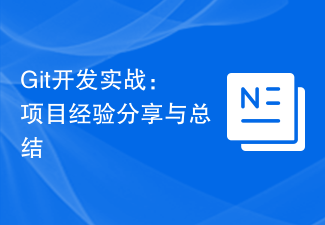
Vue practice: date picker component development
引言:
日期选择器是在日常开发中经常用到的一个组件,它可以方便地选择日期,并提供各种配置选项。本文将介绍如何使用Vue框架来开发一个简单的日期选择器组件,并提供具体的代码示例。
一、需求分析
在开始开发之前,我们需要进行需求分析,明确组件的功能和特性。根据常见的日期选择器组件功能,我们需要实现以下几个功能点:
- 基础功能:能够选择日期,并显示选择的日期。
- 日期范围限制:可以限制选择的日期范围,例如只能选择今天以后的日期。
- 快捷选择:提供快捷选择选项,例如选择最近一周、最近一个月等。
- 可配置项:组件需要提供一些可配置选项,例如日期格式、语言、起始日期等。
二、组件设计
我们可以将日期选择器组件拆分为以下几个子组件:
- Header组件:用来显示年份和月份,并提供切换年份和月份的按钮。
- Calendar组件:用来显示日历,并提供点击选择日期的功能。
- Shortcut组件:用来显示快捷选择选项,并触发相应的选项。
- Config组件:用来显示配置选项,并将配置的结果传递给其他组件。
三、组件开发
根据上述设计,我们可以开始开发日期选择器组件。
-
Header组件:
<template> <div class="header"> <button @click="prevYear"><</button> <span>{{ year }}</span> <button @click="nextYear">></button> <button @click="prevMonth"><</button> <span>{{ month }}</span> <button @click="nextMonth">></button> </div> </template> <script> export default { data() { return { year: new Date().getFullYear(), month: new Date().getMonth() + 1 }; }, methods: { prevYear() { this.year--; }, nextYear() { this.year++; }, prevMonth() { if (this.month === 1) { this.year--; this.month = 12; } else { this.month--; } }, nextMonth() { if (this.month === 12) { this.year++; this.month = 1; } else { this.month++; } } } }; </script> -
Calendar组件:
<template> <div class="calendar"> <div class="weekdays"> <span v-for="weekday in weekdays">{{ weekday }}</span> </div> <div class="days"> <span v-for="(day, index) in days" :key="index" @click="selectDate(day)">{{ day }}</span> </div> </div> </template> <script> export default { data() { return { weekdays: ["Sun", "Mon", "Tue", "Wed", "Thu", "Fri", "Sat"], days: [] }; }, methods: { selectDate(day) { // 处理选择日期的逻辑 } } }; </script> -
Shortcut组件:
<template> <div class="shortcut"> <button v-for="option in options" :key="option.value" @click="selectShortcut(option)">{{ option.label }}</button> </div> </template> <script> export default { data() { return { options: [ {label: "最近一周", value: 7}, {label: "最近一个月", value: 30}, // 更多快捷选择的配置 ] }; }, methods: { selectShortcut(option) { // 处理选择快捷选项的逻辑 } } }; </script> -
Config组件:
<template> <div class="config"> <label>日期格式:</label> <input v-model="dateFormat" placeholder="YYYY-MM-DD" /> <label>语言:</label> <select v-model="language"> <option value="zh">中文</option> <option value="en">English</option> </select> <!-- 更多配置选项 --> </div> </template> <script> export default { data() { return { dateFormat: "YYYY-MM-DD", language: "zh" }; } }; </script>
四、组件集成
上述四个子组件只是日期选择器组件的一部分,我们还需要将它们整合到一个父组件中,以完成一个完整的日期选择器组件。
<template>
<div class="date-picker">
<Header />
<Calendar />
<Shortcut />
<Config />
</div>
</template>
<script>
import Header from "./Header";
import Calendar from "./Calendar";
import Shortcut from "./Shortcut";
import Config from "./Config";
export default {
components: {
Header,
Calendar,
Shortcut,
Config
}
};
</script>总结:
本文介绍了使用Vue框架开发日期选择器组件的方法,并提供了具体的代码示例。该组件实现了基础功能、日期范围限制、快捷选择、以及可配置选项等功能,并通过拆分成多个子组件的方式使组件结构更加清晰。你可以根据实际需求对该组件进行扩展和优化,以满足自己的具体需求。
The above is the detailed content of Vue practice: date picker component development. For more information, please follow other related articles on the PHP Chinese website!
 手把手教你uniapp和小程序分包(图文)Jul 22, 2022 pm 04:55 PM
手把手教你uniapp和小程序分包(图文)Jul 22, 2022 pm 04:55 PM本篇文章给大家带来了关于uniapp跨域的相关知识,其中介绍了uniapp和小程序分包的相关问题,每个使用分包小程序必定含有一个主包。所谓的主包,即放置默认启动页面/TabBar 页面,以及一些所有分包都需用到公共资源/JS 脚本;而分包则是根据开发者的配置进行划分,希望对大家有帮助。
 MySQL表设计实战:创建一个电商订单表和商品评论表Jul 03, 2023 am 08:07 AM
MySQL表设计实战:创建一个电商订单表和商品评论表Jul 03, 2023 am 08:07 AMMySQL表设计实战:创建一个电商订单表和商品评论表在电商平台的数据库中,订单表和商品评论表是两个非常重要的表格。本文将介绍如何使用MySQL来设计和创建这两个表格,并给出代码示例。一、订单表的设计与创建订单表用于存储用户的购买信息,包括订单号、用户ID、商品ID、购买数量、订单状态等字段。首先,我们需要创建一个名为"order"的表格,使用CREATET
 Golang实战:数据导出功能的实现技巧分享Feb 29, 2024 am 09:00 AM
Golang实战:数据导出功能的实现技巧分享Feb 29, 2024 am 09:00 AM数据导出功能在实际开发中是非常常见的需求,特别是在后台管理系统或者数据报表导出等场景中。本文将以Golang语言为例,分享数据导出功能的实现技巧,并给出具体的代码示例。1.环境准备在开始之前,确保已经安装好Golang环境,并且熟悉Golang的基本语法和操作。另外,为了实现数据导出功能,可能还需要使用第三方库,比如github.com/360EntSec
 Java开发实战:集成七牛云云存储服务实现文件上传Jul 06, 2023 pm 06:22 PM
Java开发实战:集成七牛云云存储服务实现文件上传Jul 06, 2023 pm 06:22 PMJava开发实战:集成七牛云云存储服务实现文件上传引言随着云计算和云存储的发展,越来越多的应用程序需要将文件上传至云端进行存储和管理。云存储服务的优势在于高可靠性、可扩展性和灵活性。本文将介绍如何使用Java语言开发,集成七牛云云存储服务,实现文件上传功能。七牛云简介七牛云是国内领先的云存储服务提供商,其提供了全面的云存储和内容分发服务。用户可以通过七牛云提
 深入学习 Elasticsearch 查询语法与实战Oct 03, 2023 am 08:42 AM
深入学习 Elasticsearch 查询语法与实战Oct 03, 2023 am 08:42 AM深入学习Elasticsearch查询语法与实战引言:Elasticsearch是一款基于Lucene的开源搜索引擎,主要用于分布式搜索与分析,广泛应用于大规模数据的全文搜索、日志分析、推荐系统等场景。在使用Elasticsearch进行数据查询时,灵活运用查询语法是提高查询效率的关键。本文将深入探讨Elasticsearch查询语法,并结合实际案例给出
 Vue实战:日期选择器组件开发Nov 24, 2023 am 09:03 AM
Vue实战:日期选择器组件开发Nov 24, 2023 am 09:03 AMVue实战:日期选择器组件开发引言:日期选择器是在日常开发中经常用到的一个组件,它可以方便地选择日期,并提供各种配置选项。本文将介绍如何使用Vue框架来开发一个简单的日期选择器组件,并提供具体的代码示例。一、需求分析在开始开发之前,我们需要进行需求分析,明确组件的功能和特性。根据常见的日期选择器组件功能,我们需要实现以下几个功能点:基础功能:能够选择日期,并
 MySQL表设计实战:创建一个电影信息表和演员表Jul 01, 2023 pm 08:16 PM
MySQL表设计实战:创建一个电影信息表和演员表Jul 01, 2023 pm 08:16 PMMySQL表设计实战:创建一个电影信息表和演员表导语:在数据库设计中,表的创建是一个非常关键的环节。本文将以电影信息表和演员表为例,详细介绍如何进行MySQL表的设计和创建,并附上相应的代码示例。一、电影信息表设计和创建电影信息表是用来存储电影的相关信息,包括电影名称、导演、上映时间、电影类型等字段。下面是电影信息表的设计和创建过程,首先我们需要选择合适的字
 Git开发实战:项目经验分享与总结Nov 04, 2023 pm 12:32 PM
Git开发实战:项目经验分享与总结Nov 04, 2023 pm 12:32 PMGit是一款分布式版本控制系统,广泛应用于软件开发领域。在实际的项目开发中,合理利用Git进行团队协作和版本管理,能够极大地提高开发效率和项目质量。本文将分享我在Git开发中的实战经验,并总结一些注意事项和技巧,希望对读者有所启发和帮助。一、团队协作之分支管理在多人协作的项目中,充分利用Git的分支管理功能,能够更好地进行团队协作和版本控制。通常情况下,主干


Hot AI Tools

Undresser.AI Undress
AI-powered app for creating realistic nude photos

AI Clothes Remover
Online AI tool for removing clothes from photos.

Undress AI Tool
Undress images for free

Clothoff.io
AI clothes remover

AI Hentai Generator
Generate AI Hentai for free.

Hot Article

Hot Tools

SAP NetWeaver Server Adapter for Eclipse
Integrate Eclipse with SAP NetWeaver application server.

PhpStorm Mac version
The latest (2018.2.1) professional PHP integrated development tool

DVWA
Damn Vulnerable Web App (DVWA) is a PHP/MySQL web application that is very vulnerable. Its main goals are to be an aid for security professionals to test their skills and tools in a legal environment, to help web developers better understand the process of securing web applications, and to help teachers/students teach/learn in a classroom environment Web application security. The goal of DVWA is to practice some of the most common web vulnerabilities through a simple and straightforward interface, with varying degrees of difficulty. Please note that this software

SublimeText3 English version
Recommended: Win version, supports code prompts!

ZendStudio 13.5.1 Mac
Powerful PHP integrated development environment






